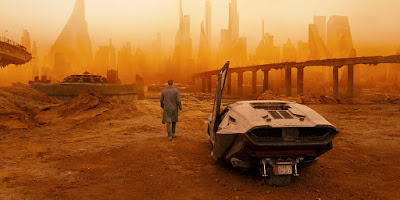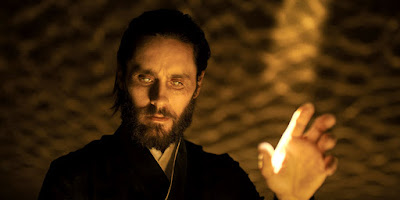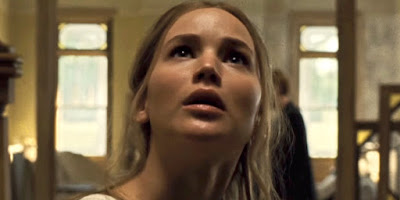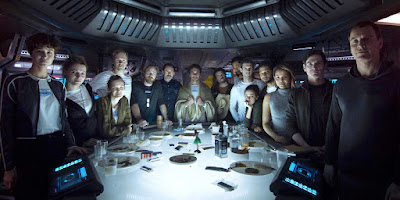Zack Snyder strikes me as a man who would corner you at a party and evangelize over Atlas Shrugged. He also strikes me as someone who not only thinks Atlas Shrugged was written by John Galt, he also keeps referring to the Ayn Rand character as ‘Don Gall’. Joss Whedon, on the other hand, reminds me of every loud, industry wannabe who’s constantly holding court at your local comic shop. Someone whose idea of a joke is saying anything with a sarcastic lilt or whose conception of female empowerment is I SPIT ON YOUR GRAVE if it was watered down with Scooby Doo references. Together the pair has reaffirmed the public-at-large’s most unfair, clichéd perceptions of nerd culture. It’s also why I treated their unintentional collaboration on JUSTICE LEAGUE with the same degree of apprehension you give to a blood test you know will come back positive. You just sit there trying to keep the inevitable at bay with happy but empty thoughts like “Maybe it’s going to be OK” or “Maybe it burns because I’ve been drinking too much coffee? That’s a side effect from drinking too much coffee, right?” but, no. Eventually reality proves your instincts were correct and not only was JUSTICE LEAGUE terrible but you’re kind of justifying the pain and disappointment by telling people things like, “Well, Robin Williams had it too.” Basically, what I’m trying to say is that I hated JUSTICE LEAGUE and I have herpes. Also, I have been told by a reliable source that -- legally -- this counts as a phone call.
Like Universal’s failed Dark Universe franchise, JUSTICE LEAGUE is the by-product of a rushed, knee jerk reaction to Marvel’s Cinematic Universe. Whereas the original AVENGERS was seen as a fun possibility if the other franchises did well enough, JUSTICE LEAGUE was going to happen whether or not MAN OF STEEL was a hit. Basing a billion dollar franchise around something so forced and inorganic isn’t quite ‘starting off on the wrong foot’ as much as it’s ‘getting pushed out of a wheelchair and landing on your stump’. In addition to the film’s cynical origins, JUSTICE LEAGUE also suffered from severe retooling after audiences and critics alike recoiled from the adolescent nihilism of Snyder’s BATMAN V. SUPERMAN. Snyder also had to leave the project halfway through its production due to tragic family issues. Whedon was then called in to finish the film in a directorial style similar to Snyder’s, something he was either unable or unwilling to achieve. With odds that overwhelming, it’s surprising that JUSTICE LEAGUE didn’t share the same fate as Tim Burton’s SUPERMAN LIVES.
It’s also disappointing.
JUSTICE LEAGUE is the kind of film that could have benefitted from a cancellation or a shelving or even a man to stand behind you covering your eyes with his hands. Anything that would have prevented anyone from gazing towards its direction and frowning. Although many will disagree, JUSTICE LEAGUE is worse than BATMAN V. SUPERMAN because the whiff of compromise is so incredibly strong. BATMAN V. SUPERMAN may have been the cinematic equivalent to a 35-year-old man storming off to his bedroom screaming, "They’re not called funny books, Mother," but at least it was tonally consistent. In JUSTICE LEAGUE all of that grim-dark, ‘please-take-superheroes-seriously’ bullshit awkwardly clangs against Whedon’s desperate attempts to Marvel-up the proceedings in a way that only Whedon can. Which is basically what Aaron Sorkin would do if Aaron Sorkin punctuated his quips by flicking Cheeto dust in your eyes. It’s all cutesy, joke-like dialogue combined with nerdiness so cringe-inducing it’s practically weaponized.
If JUSTICE LEAGUE is a movie, then one of those ‘This Season on GAME OF THRONES’ promos that run at the end of a season-opening episode is a movie. It’s just a feature length highlight reel of disconnected scenes that won’t make dramatic sense until the entire series unfolds -- and that seems about as unlikely as seeing a second Dark Universe movie. Of course, the confusion begins in the most obnoxious way possible: a slo-mo title sequence that looks like the dumbest guy in your high school stopped making YouTube videos of himself headbutting steel blade fans to make socially relevant videos for Staind. It’s Snyder at his most self-important and obvious, clumsily dragging real world issues into a movie where The Flash (Ezra Miller) faceplants into Wonder Woman’s (Gal Gadot) cleavage. In the intro, a skinhead wearing a black hoodie with the word MAGA silk-screened on it in the death metal font is shown kicking over a fruit cart owned by a woman in a hijab. Presumably, a scene following that in which a cackling man dressed as the Monopoly guy strangling a woman with the words ‘a living wage’ written on her chest as a teary-eyed Uncle Sam looks on was cut for time. If obvious editorial cartoons adapted and re-contextualized by whatever editing software Snyder uses to make all of his films look a photocopy of a photocopy of '300' aren’t your thing, know that he’s doing something similar with New Yorker cartoons. At the end of the sequence, a homeless man carries a sign reading “I Tried” and, although intended to be poignant, it feels like a laziest gag Roz Chast never drew. At any rate, what this overwrought sequence is trying to convey is that the world isn’t the same since Superman died in BATMAN V. SUPERMAN, even though the world was still pretty terrible when he was alive, what with all the rogue Michael Shannons flying around and the Senate exploding and people pissing into mason jars. Yet, regardless of how the world feels about the loss of Superman, the film more or less forgets about him and starts performing random chores until about halfway through the running time when the film suddenly stops bopping along to that Rebel Just for Kicks song playing at Target while it shops for detergent to remember, “Oh, shit! Superman is supposed to be in this!” At which point, Henry Cavill’s smug, Ted Bundy-like take on the Last Son of Krypton is hastily resurrected. And what an abrupt, anticlimactic resurrection. Imagine if Dr. Frankenstein brought his creation to life by throwing a toaster into a bathtub. That’s basically the extent of what happens here. Members of the Justice League dig up Superman’s corpse and dump his body into that Kryptonian amniotic chamber from BATMAN V. SUPERMAN that transformed a rubbery Michael Shannon dummy into a shambling wad of CGI animated dough that was probably more expensive than the Shannon dummy but looks far cheaper. As stupid as the “healing coma” was that brought Superman back to life in the infamous Death of Superman comic story, at least that didn’t involve Flash and Cyborg (Ray Fisher) heading into the moors with wooden spades like Burke and fucking Hare.
In any other movie, the resurrection of an iconic figure like Superman would be, if not the point of the movie, then at least a strong B-story. In this film it’s treated as an afterthought because JUSTICE LEAGUE is attempting to do in one movie what Marvel Studios did in six two-hour movies. Not only is it dealing with the rebirth of a major character, there’s also a plot involving something that looks like somebody’s ill-considered World of Warcraft avatar (the voice of Ciaran Hinds) stealing several “motherboxes” to annoy a wacky Siberian family? I guess? To those who have seen the film, what was the point of repeatedly cutting back to that family? To get hilarious gags where the daughter jokingly attempts to defend herself with bug spray? Because it’s not enough that two very different movies with ever changing, inconsistent tones that are not so quietly at war with each other, we also get fragments from the solo Aquaman, Cyborg and Flash movies -- that should’ve happened prior to JUSTICE LEAGUE -- wedged awkwardly into this mess. Out of the three, the Cyborg mini-movie is the default winner mainly for the presence of Joe Morton and relative newcomer Fisher. Aquaman (Jason Momoa), on the other hand, feels like RENEGADE-era Lorenzo Lamas, a Capri Sun commercial from the mid-90s and the intro to VIVA LA BAM were consumed and pissed into a bottle of Venom Energy Drink. He’s everything you thought was totally bad-ass when you were twelve and it’s embarrassing. But not nearly as embarrassing as The Flash. Ezra Miller -- usually good as creeps and weirdoes -- has a lot to say in this movie and it’s almost all in the form of precious zingers! Did you know he’s a black hole of snacking? You might say he’s a snack hole! Oh, that’s not his superhero suit, Batman. He’s a COMPETITIVE ICE DANCER!!! You can’t sit there, Penny! That’s Sheldon’s chair! Bazimples! He’s so adorably awkward it’s like seeing Zoey Deschanel play The Flash but without the thrill of her playing the SUPERFRIENDS theme on a ukulele really fast. A character who reeks of Whedon’s most grating tics, The Flash is clearly intended to be an audience surrogate even though he’s an obnoxious coward too afraid to do anything and never stops flapping his unfunny jaws. So, there you go DC movie fans, Whedon thinks you’re The Flash.
And that’s not all, we also get an amazing number of scenes where a dead-eyed, emotionally drained Ben Affleck trundles around in his bat suit without the cowl looking like a mopier version of Ralphie’s snowsuit bound little brother in A CHRISTMAS STORY, a cringe-inducing moment where Diane Lane and Amy Adams joke about “being thirsty,” J.K. Simmons standing around and not doing anything that would require him to get as buff as he was in the pre-production photos, Cavill’s distracting CGI upper lip and constant reminders that only Patty Jenkins seems to know what to do with Wonder Woman. In Snyder and Whedon’s JUSTICE LEAGUE, Wonder Woman is reduced to a den mother/fuck object whose superpowers seem to be looking stoic and reminding you she has an ass. Basically, she’s become the DC Universe’s equivalent to Black Widow. But as dumb and as ill-conceived as all of that may be, JUSTICE LEAGUE fails because it’s boring. For a film with so much story and characters, it’s surprising how slowly JUSTICE LEAGUE moves. It lacks the pacing of even a bad Marvel Studios movie, which is why I’m shocked that some people find this movie fun. Is it just for the thrill of seeing deep cut characters like Steppenwolf, the Parademons, Aquaman and the Green Lantern Corp. interact on the Silver Screen? Because I felt the same way after seeing Killer Croc and Captain Boomerang in SUICIDE SQUAD. Eventually the thrill goes away and all you’re left with is severe discomfort and a prescription for Valtrex. Seriously Janet, I’m not fooling around. Call a doctor immediately because you might have it too.



































